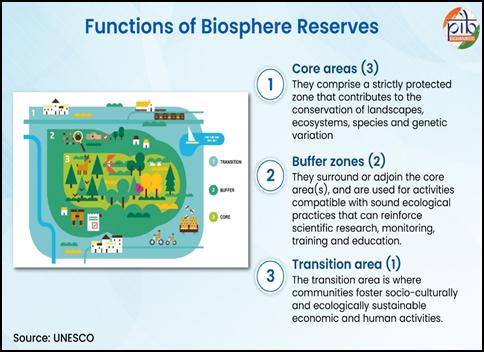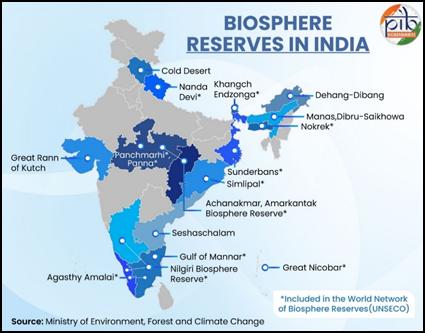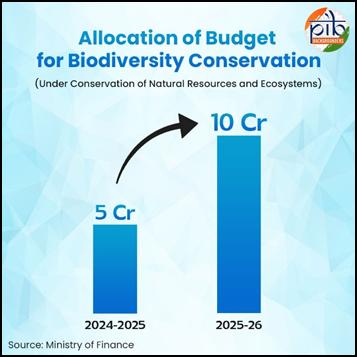PIB Headquarters
Sustaining Life, Celebrating Nature: India’s Biosphere Reserves
Celebrating International Day of Biosphere Reserves
प्रविष्टि तिथि:
03 NOV 2025 11:49AM by PIB Delhi
|
Key Takeaways
- The country has 18 Biosphere Reserves covering 91,425 sq. km, with 13 recognized by UNESCO.
- The programme operates under a Centrally Sponsored Scheme with a 60:40 funding pattern, and 90:10 for North Eastern and Himalayan states.
- India ranks 9th globally in forest area and 3rd in annual forest gain (FAO, 2025).
- The inclusion of the Cold Desert Biosphere Reserve in 2025 underscores India’s growing global conservation role.
- Biodiversity conservation budget has doubled from ₹5 crore in 2024-25 to ₹10 crore in 2025-26.
- Biosphere Reserves link biodiversity protection with community welfare and sustainable livelihood opportunities.
- National initiatives like Project Tiger, Project Elephant, and Green India Mission complement Biosphere Reserve efforts.
|
Introduction
On November 3, the world observes the International Day for Biosphere Reserves, celebrating regions where nature and communities coexist in harmony. These reserves serve as living laboratories that demonstrate practical models of sustainable development, environmental conservation, and community well-being. Designated by UNESCO, the day underscores the importance of biosphere reserves as vital platforms for advancing scientific research, preserving ecological and cultural diversity, and fostering a balanced relationship between people and the planet.
India celebrates this day alongside the world, highlighting its strong network of biosphere reserves that stretch across diverse terrains: mountains, forests, coasts, and islands. These areas demonstrate India's commitment to conserving biodiversity and fostering harmonious living between people and nature through both national initiatives and international frameworks like the UNESCO Man and Biosphere (MAB) Programme.
The Government of India’s ongoing efforts reinforce the potential of biosphere reserves to protect ecological riches and promote the well-being of present and future generations. These reserves continue to prove that sustainable living and conservation can go hand in hand.
What are Biosphere Reserves?

Biosphere reserves are areas identified by national governments for conserving biodiversity and promoting sustainable development. They have been described as ‘learning places for sustainable development’. They are sites for testing interdisciplinary approaches to understanding and managing changes and interactions between social and ecological systems, including conflict prevention and management of biodiversity. Biosphere reserves include terrestrial, marine and coastal ecosystems. Each site promotes solutions reconciling the conservation of biodiversity with its sustainable use.
Biosphere reserves are nominated by national governments and remain under the sovereign jurisdiction of the states where they are located.
BRs are thus special environments for both people and the nature and are living examples of how human beings and nature can co-exist while respecting each other’s needs.
Did you know?
More than 260 million (26 Crore) people live in biosphere reserves across the world. Altogether, these sites protect more than 7 million km2, an expanse roughly equal to the size of Australia.
UNESCO Man and Biosphere Programme
Biosphere Reserves are areas of terrestrial, coastal or ecosystems internationally recognized under UNESCO’s Man and Biosphere (MAB) Programme. These reserves must meet specific criteria and conditions before being included in the World Network of Biosphere Reserves (WNBR) designated by UNESCO. The network represents the world’s major ecosystem types and landscapes, dedicated to conserving biodiversity, promoting research and monitoring, and providing models of sustainable development.
It combines the natural and social sciences with a view to improving human livelihoods and safeguarding natural and managed ecosystems, thus promoting innovative approaches to economic development that are socially and culturally appropriate and environmentally sustainable.
By focusing on sites internationally recognized within the World Network of Biosphere Reserves, the MAB Programme strives to
- Identify and assess the changes in the biosphere resulting from human and natural activities and the effects of these changes on humans and the environment, in particular in the context of climate change.

- Study the interrelationships between ecosystems and socio-economic processes amid loss of biological & cultural diversity that hinders ecosystems provision of services for human wellbeing
- Ensure basic human welfare and a liveable environment in the context of rapid urbanization and energy consumption as drivers of environmental change.
- Promote the exchange and transfer of knowledge on environmental problems and solutions, and to foster environmental education for sustainable development.
The WNBR forms a dynamic network of sites of excellence that encourages collaboration across regions and fosters international cooperation through exchange of experiences, capacity-building, and promotion of best practices among Biosphere Reserves.
The MAB Programme operates under the guidance of UNESCO Member States.
Its main governing body is the International Coordinating Council (MAB-ICC), also known as MAB Council, which is composed of 34 Member States
Biosphere Reserves in India

India has 18 notified Biosphere Reserves covering approximately 91,425 sq. km, of which 13 are recognized by UNESCO’s World Network of Biosphere Reserves (WNBR). These reserves span diverse landscapes, from mountains and forests to coasts and islands, showcasing India’s ecological richness and commitment to conserving biodiversity while supporting local communities.
The Biosphere Reserve Division of the Ministry of Environment, Forest, and Climate Change (MoEFCC) administers a Centrally Sponsored Scheme (CSS) for Biodiversity Conservation, which operates as a sub-scheme under the broader Conservation of Natural Resources and Ecosystems (CNRE) programme.
The scheme provides financial assistance to states for targeted conservation and development activities, with implementation primarily handled by State Forest Departments.

The scheme follows a cost-sharing model: 60:40 (Central: State) and 90:10 for the North Eastern and Himalayan states.
The budget allocation for biodiversity conservation under CNRE has doubled from ₹5 crore in 2024-25 to ₹10 crore in 2025-26, highlighting the government’s increasing commitment to sustainable ecosystem management.
What sets this scheme apart is its focus on local communities, particularly those living in and around Biosphere Reserves. By promoting alternative livelihoods, eco-development activities, and sustainable resource management, the scheme helps reduce biotic pressure on core biodiversity zones.
Special emphasis is placed on buffer and transition zones, providing supplementary support to minimize dependence on critical ecosystems and ensure long-term sustainability.
India’s Biosphere Reserves not only conserve biodiversity but also serve as living laboratories for sustainable development, integrating ecological protection with community welfare. They complement other national initiatives, such as Project Tiger, Project Elephant, Green India Mission, and the National Biodiversity Action Plan, creating a holistic framework for conservation and sustainable livelihoods.
In essence, India’s Biosphere Reserve programme exemplifies the balance between nature and human development, demonstrating how environmental stewardship, scientific research, and socio-economic support can coexist to secure ecological and community well-being.
In September 2025, India’s Cold Desert Biosphere Reserve in Himachal Pradesh was included in UNESCO’s World Network of Biosphere Reserves.
Impact of Conservation Efforts
The establishment of Biosphere Reserves in India reflects a long-term national vision for conservation and sustainable development aligned with global environmental goals under UNESCO’s Man and the Biosphere (MAB) Programme. India is at the forefront of promoting and managing Biosphere Reserves, showcasing its dedication to conserving biodiversity, empowering local communities, and advancing sustainable ecosystem practices.
- Biosphere Reserves have significantly contributed to maintaining ecosystem balance, enabling conservation of biodiversity, and strengthening climate resilience in fragile habitats. They serve as demonstration sites for sustainable practices and provide economic and livelihood security to forest-dependent populations through alternate livelihood measures.
- India’s implementation of the Biosphere Reserve Programme has also supported measurable improvements in forest health indicators. As of October 2025, India ranked 9th globally in total forest area and 3rd in annual forest gain, according to the Food and Agriculture Organization’s Global Forest Resources Assessment (GFRA) 2025.
- Continuous monitoring, enhanced community participation, and expansion of the Biosphere Reserve network have collectively strengthened India’s position among global leaders in forest and biodiversity conservation.
- Biosphere Reserves complement India’s broader conservation framework by linking habitat protection with sustainable community development. These reserves act as living laboratories where integrated approaches from converge to strengthen ecosystem resilience and conserve species across diverse landscapes.
Several national schemes operate in alignment with the objectives of Biosphere Reserves, contributing collectively to habitat conservation, sustainable resource use, and community development. Some of these are as follows:
- Project Tiger– Initiated in 1973, has been India's flagship conservation initiative, successfully completing 50 years in 2023. Focused on tiger conservation through dedicated reserves and strict protection measures, it has played a crucial role in reviving tiger populations.
- Project Elephant – India, home to over 60% of the global Asian elephant population, has undertaken significant measures to protect and conserve these majestic animals. Project Elephant is a flagship initiative aimed at ensuring the long-term survival of elephants in their natural habitats. This program focuses on habitat preservation, human-elephant conflict mitigation, and the welfare of captive elephants, reflecting India's deep-rooted cultural and ecological commitment to elephant conservation.
- Integrated Development of Wildlife Habitats (IDWH) Scheme –This centrally sponsored scheme provides financial and technical assistance to state and union territory governments for wildlife conservation activities.
- National Biodiversity Action Plan (NBAP) – The NBA, established under the Biological Diversity Act, 2002, is entrusted with the crucial responsibility of regulating access to India’s vast biological resources and associated traditional knowledge.
- Eco-Sensitive Zones (ESZs) and Wildlife Corridors – Eco-sensitive Zones around Protected Areas i.e. National Parks and Wildlife Sanctuaries. The purpose of declaring ESZ is to create some kind of “Shock Absorber” for the specialized Ecosystem, such as Protected Areas or other natural sites and is meant to act as a transition zone from areas of high protection to areas involving lesser protection.
- Green India Mission- The mission aims to protect, restore, and enhance India’s forest cover while tackling climate change. GIM focuses on improving biodiversity, water resources, and ecosystems like mangroves and wetlands, all while helping absorb carbon.
Conclusion
India’s observance of the International Day for Biosphere Reserves highlights the country’s enduring commitment to biodiversity conservation and sustainable development. By integrating ecological protection with community empowerment, India’s biosphere reserves function as living examples of harmony between nature and people, supported by national policies and international partnerships like UNESCO’s Man and Biosphere programme. With a growing network of reserves, increased forest cover, and active collaboration for innovative and inclusive approaches, India continues to set benchmarks in global conservation. These efforts ensure that both ecological treasures and local communities thrive, strengthening India’s role as a leader in sustainable living for present and future generations.
References
UNESCO
Ministry of Environment, Forest and Climate Change
Food and Agriculture Organization of the United Nations
PIB Headquarters
NCERT:
Click here to see pdf
****
SK | SA
(रिलीज़ आईडी: 2185715)
आगंतुक पटल : 9976